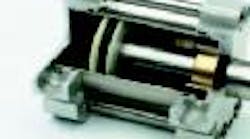CD highlights features and specifications of EVP proportional control valves, which provide control of air or gas flow, by varying the output flow based on current input to the solenoid. Consistent gain provides a high degree of control for many applications. Uses DC current, open-or closed-loop control, and PWM (pulse width modulation) to cover a broad range of applications.
Clippard Instrument Laboratory Inc., (888) 256-2178 www.clippard.com/evp-h


